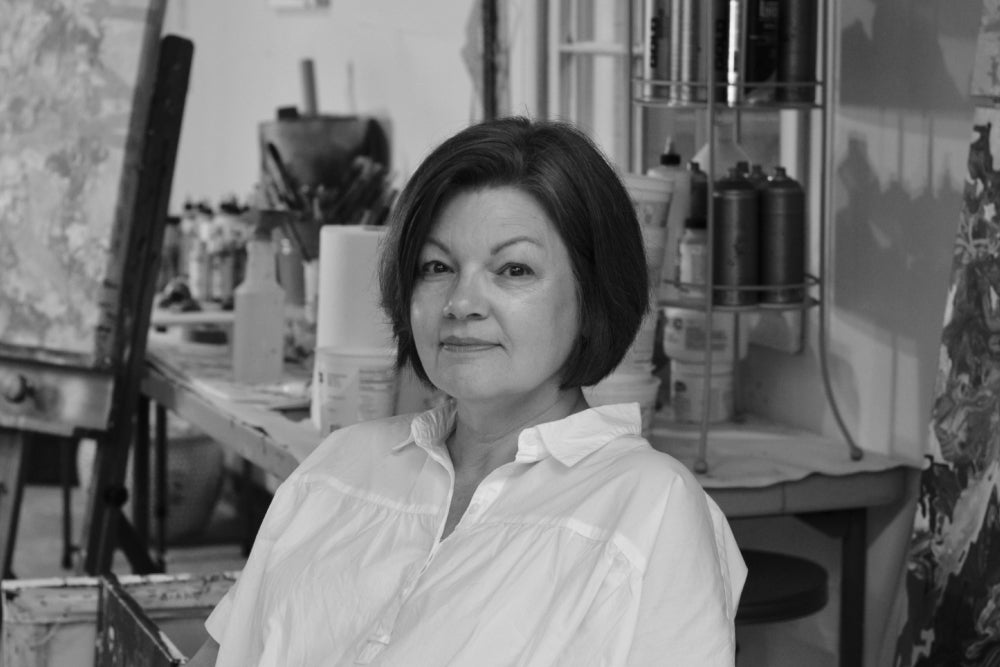Raleigh, NC
PAINTING
For abstract artist Martha Thorn, diligence and dedication to her craft are paramount — but excessive planning is something to avoid. She prefers to paint intuitively, focusing on materials and the process of making, allowing meanings and underlying themes to reveal themselves slowly, sometimes after she has finished a piece. “Later, I may find connections between my work and quotidian details, such as something I noticed on a daily walk,” she explains. “Stripes I’ve recently felt compelled to paint turned out to be fencing put up during protests that I turned on its side.” In one such painting entitled Climb for Optimism, stark yellow stripes that very nearly evoke the shade and shape of crime scene tape instead feel bright, sunny and reaching. Even the blood-red tones that threaten to dominate acrylic pouring sections of the piece meet their match in bright pools of color mixing blues, pinks and greens that draw the eye.

ARTIST'S NOTE
“Periodically sweep all of the ‘shoulds’ floating around your studio into a pile. Inspect them closely and decide which can stay and which need to be gingerly placed in the trash can.”
This juxtaposition of hard-edged geometric abstraction with fluid art and graffiti-leaning elements that Thorn has become known for was certainly not planned, nor was it present in her earlier work. In fact, when she first left her job as a graphic designer to paint full time, she felt she had to completely separate the two disciplines in order to be successful as a painter. But upon visiting a Whitney Biennial, she was so struck by the diverse skill sets used to make all the work on exhibit that she made the decision to incorporate her graphic design experience into her painting practice. It was a turning point for the North Carolina artist, who has since grown to embrace experimentation more widely, finding joy in the freedom from constraints that painting non-objectively allows. For Thorn, it’s all about process and being present enough to fully experience and appreciate the physicality of her materials — the particular properties of spray paint, inks, paint, pen, and within acrylic paint, the differences in body and fluidity. She says it is from that space that she can get her bearings and begin to create with abandon. “Then I start to ‘clean up,’ hopefully reducing the chaos in a painting by just one degree so that it becomes a successful, cohesive painting bordering on the brink of disaster,” explains Thorn. “The dichotomies of chaos and peace, dirty and clean, ugliness and beauty are recurrent themes in my work.”
![]()

Tell us about a piece of your work that’s especially meaningful to you?
“A Girl Called Whisper comes to mind. My husband and I took my mother-in-law to breakfast at a diner one morning. Our young waitress' name tag said, ‘Whisper.' At first, I thought it was a beautiful name, but just as quickly, I realized that a boy would have never been named that. And it upset me thinking that this girl had been silenced from birth with a name that was also a command. Months later, when I was studying a small yet ‘loud' piece, filled with high-chroma color, I realized that I had made a painting that could shout for her. And though she will never know, it was fulfilling. It frequently happens that I make connections to events only after I've made work encompassing them. I treasure those moments.”
If you could meet any artist (living or dead) who would it be and why?
“I’d want to meet one of the Ice Age artists whose eight-miles long, 12,000-year-old cliff paintings were discovered recently in Colombia. I'm fascinated with artifacts and would be interested to hear a first-hand account of the process and the reasons behind the creation of the paintings. I would ask her if she made images to serve as documentation or if they were instead a by-product of a sacred act of making.”
Was there a particular teacher who has influenced your work?
“Judith Duffy was a drawing instructor I had in art school. She encouraged and pushed me, which is why I have strong drawing skills. But more than that, she painted with her own blood, which opened for me the infinite possibilities of art.”
How have your life choices impacted your development as an artist?
“Moving to large cities had a significant impact on my art, as I visited museums multiple times. For instance, living in (rather than visiting) DC allowed me to see Woman by de Kooning at the Hirshhorn more than once. Having the luxury of studying a few pieces per visit, I was able to look at the artists' processes and details that I might have missed otherwise. Being able to scrutinize works in person was vital in helping me develop as a painter.”





